CSAT vs NPS Which Metric Matters Most for Customer Experience in 2025
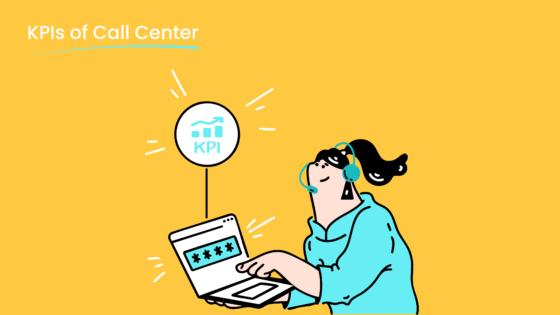
You know that customer satisfaction plays a crucial role in shaping business success. Metrics like CSAT and NPS help you measure satisfaction and loyalty effectively. With customer service expectations reaching new heights, it’s vital to choose the right metric to meet evolving demands.
- 93% of customer service teams agree that expectations have never been higher.
- 87% of support teams believe the bar for service quality rose significantly in 2023.
By understanding what is CSAT in customer service and how it compares to NPS, you can align your strategy with industry trends. Tools like Sobot’s solutions can further enhance your ability to track overall satisfaction efficiently.
What Is CSAT in Customer Service and How Does It Compare to NPS?
Definition and Purpose of CSAT
CSAT, or Customer Satisfaction Score, measures how happy customers are with specific interactions, products, or services. It provides immediate feedback, helping you identify areas for improvement. For example, after a customer service call, a CSAT survey might ask, "How satisfied are you with our support today?" Scores above 70% are generally considered good, with e-commerce companies often achieving averages of 80%. High CSAT scores indicate satisfied customers and a healthy business. They also help predict churn rates, as nearly 70% of customers switch companies when they feel unappreciated.
CSAT surveys are essential for understanding what is working and what needs attention. They focus on short-term satisfaction, making them ideal for evaluating specific touchpoints in the customer journey. If you want to know how to calculate CSAT, the formula is simple:
(Number of positive responses / Total responses) * 100.
Definition and Purpose of NPS
NPS, or Net Promoter Score, measures customer loyalty by asking how likely someone is to recommend your brand. This metric categorizes customers into promoters, passives, and detractors. Promoters are loyal advocates, while detractors may harm your reputation. According to Fred Reichheld, the creator of NPS, this single-question survey reveals how well your company fosters loyalty. Unlike CSAT, NPS focuses on long-term relationships and brand advocacy.
Analyzing NPS data helps you understand customer emotions and identify trends. For example, combining NPS with sentiment analysis tools can uncover pain points. Businesses that monitor NPS trends often gain a competitive edge by addressing customer concerns proactively.
Common Survey Questions for CSAT and NPS
CSAT and NPS surveys use simple yet effective questions to gather insights. Here are examples:
| Survey Type | Example Question | Scale |
|---|---|---|
| CSAT | How satisfied are you with our services? | 1-5 (1 = highly unsatisfied) |
| NPS | How likely are you to recommend us to others? | 0-10 (0 = not likely at all) |
CSAT surveys focus on specific interactions, while NPS surveys assess overall loyalty. Both are valuable tools in customer satisfaction surveys, helping you improve experiences and build stronger relationships.
CSAT vs NPS: Key Differences and Applications
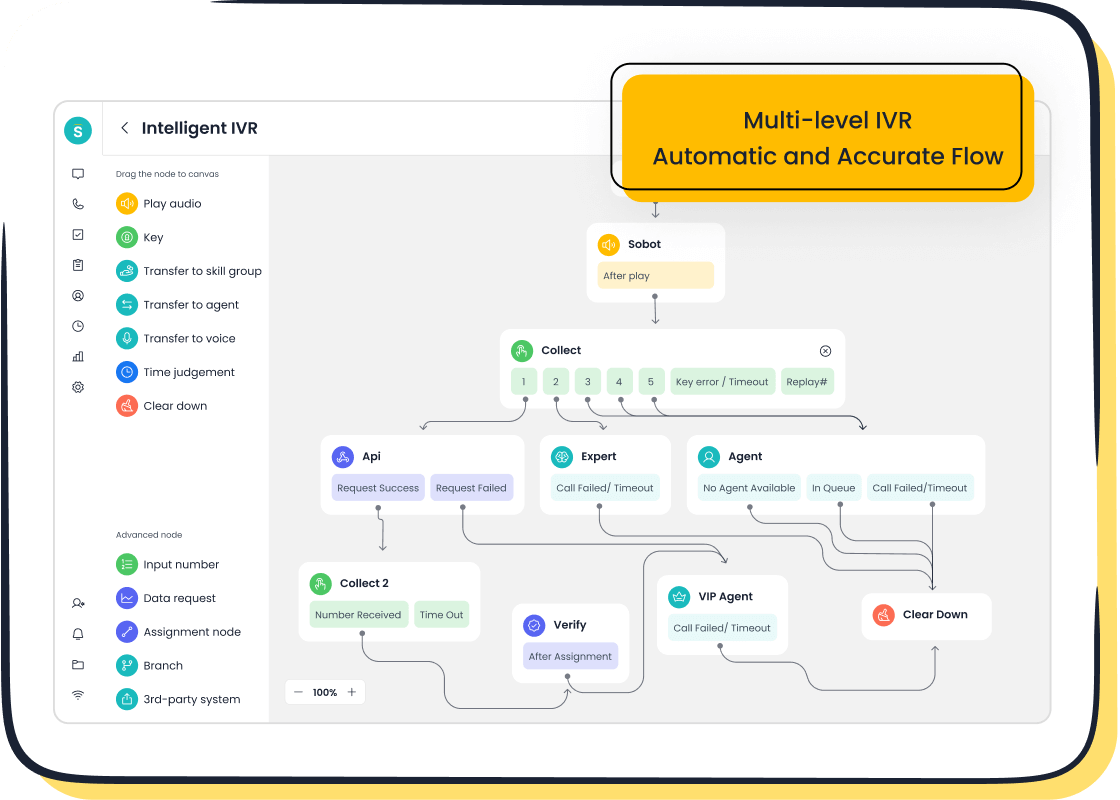
Short-Term Satisfaction vs Long-Term Loyalty
When evaluating customer satisfaction, understanding the difference between short-term satisfaction and long-term loyalty is essential. CSAT focuses on immediate feelings after specific interactions, such as a support call or product delivery. For example, a CSAT survey might ask, "How satisfied are you with your recent purchase?" This metric helps you identify areas needing immediate improvement.
NPS, on the other hand, measures loyalty over time. It asks, "How likely are you to recommend us to others?" This question reveals how customers perceive your brand overall. While CSAT captures the moment, NPS reflects the relationship. A study titled Quantifying the short- and long-term effects of promotional incentives in a loyalty program found that promotional incentives often boost short-term satisfaction but fail to enhance long-term loyalty. This insight highlights the importance of balancing both metrics to create lasting customer relationships.
| Metric | Focus | Evaluation |
|---|---|---|
| CSAT | Short-term satisfaction | Specific interactions |
| NPS | Long-term loyalty | Overall brand perception |
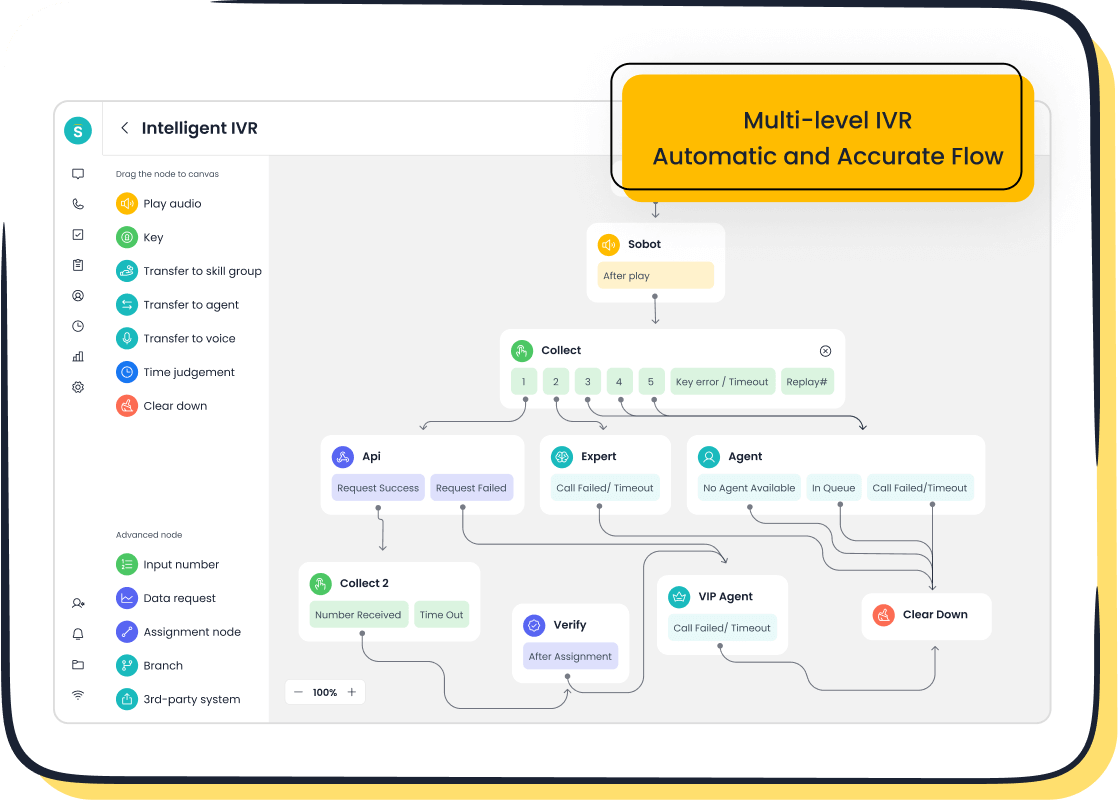
Sobot’s solutions, such as its AI-powered Voice Call Center, can help you track both metrics effectively. By automating feedback collection and analyzing trends, you can address immediate concerns while fostering loyalty.
Calculation Methods and Insights
Both CSAT and NPS rely on simple formulas to deliver actionable insights. CSAT uses the formula:
(Number of positive responses / Total responses) * 100.
This calculation gives you a percentage score that reflects customer satisfaction with specific interactions. For example, if 80 out of 100 customers rate their experience positively, your CSAT score is 80%.
NPS categorizes responses into promoters (9-10), passives (7-8), and detractors (0-6). The formula is:
NPS = % Promoters - % Detractors.
If 60% of respondents are promoters and 20% are detractors, your NPS score is 40. This score helps you gauge brand loyalty and advocacy.
Both metrics provide valuable insights, but their applications differ. CSAT highlights immediate issues, while NPS uncovers long-term trends. For example, symbolic benefits in high-end retail often enhance satisfaction, as shown in the study The effects of loyalty programs on customer satisfaction, trust, and loyalty toward high- and low-end fashion retailers.
Sobot’s Omnichannel Solution simplifies data collection and analysis across multiple channels. By integrating CSAT and NPS surveys into a unified workspace, you can gain a holistic view of customer sentiment and make informed decisions.
Use Cases in Customer Service and Support
CSAT and NPS serve distinct purposes in customer service. CSAT is ideal for evaluating specific touchpoints, such as live chat interactions or product returns. For instance, Samsung achieved a 97% customer satisfaction rate by using Sobot’s contact center solution to streamline communication and improve service quality.
NPS, however, is better suited for assessing overall loyalty. It helps you identify promoters who can become brand advocates. For example, a high NPS score indicates strong customer loyalty, which can drive referrals and repeat business.
| Metric | Use Case Example |
|---|---|
| CSAT | Measuring satisfaction after a support call |
| NPS | Tracking loyalty to predict repeat purchases |
Sobot’s AI-driven tools, such as its Voice Call Center and Omnichannel Solution, enable you to collect real-time feedback and unify metrics. These tools help you address immediate concerns while building long-term loyalty, ensuring a balanced approach to customer satisfaction.
When to Use CSAT vs NPS for Customer Satisfaction Goals
Scenarios Where CSAT Is Ideal
CSAT works best when you need to measure satisfaction with specific interactions or touchpoints. For example, after a customer completes a support call or receives a product delivery, CSAT surveys can capture immediate feedback. This metric is particularly effective in industries where quick resolutions and service quality are critical.
| Industry | Key Focus Areas for CSAT Effectiveness | Impact on Business Outcomes |
|---|---|---|
| Finance | Metrics like response time, resolution time, and customer understanding of financial products. | Enhances trust and efficiency, leading to improved customer satisfaction. |
| Technology | Post-support interaction feedback to refine services. | Helps in product feature adjustments and support process improvements, leading to higher customer satisfaction. |
| Cross-Departmental | Sharing CSAT insights across departments for collaborative improvements. | Drives marketing, sales, and product development to enhance customer experience based on feedback. |
In finance, CSAT surveys help you evaluate how well customers understand your products and services. High scores indicate trust and efficiency, which are essential for retaining clients. In technology, CSAT feedback after support interactions allows you to refine processes and improve product features. Sharing CSAT insights across departments fosters collaboration, enabling teams to align their efforts toward enhancing customer satisfaction.
Sobot’s Voice Call Center simplifies CSAT collection by automating surveys after calls. This tool ensures you receive real-time feedback, helping you address issues promptly and improve service quality.
Scenarios Where NPS Is More Effective
NPS excels when you want to measure long-term loyalty and brand advocacy. It’s ideal for identifying promoters who can drive referrals and repeat business. For example, if you’re launching a new product or entering a new market, NPS surveys can reveal how customers perceive your brand overall.
This metric is particularly useful for industries that rely on customer loyalty to sustain growth. High NPS scores indicate strong relationships, which can lead to increased customer lifetime value. For instance, T-Mobile uses NPS to measure loyalty and inform strategies for enhancing satisfaction. By identifying promoters, you can focus on nurturing these relationships to build a loyal customer base.
Sobot’s Omnichannel Solution integrates NPS surveys across multiple channels, providing a unified view of customer loyalty. This approach helps you track trends and identify areas for improvement, ensuring your brand remains competitive.
Aligning Metrics with Business Objectives
Aligning CSAT and NPS with your business goals ensures you maximize their impact. Each metric serves a unique purpose, but together they provide a comprehensive view of customer satisfaction and loyalty.
| Company | Metric/Statistic | Purpose/Outcome |
|---|---|---|
| Bank of America | Customer Retention Rate | Measures success in enhancing customer loyalty and reducing churn. |
| Bank of America | Net Promoter Score (NPS) | Assesses customer loyalty and informs improvement strategies. |
| Bank of America | Average Order Value (AOV) | Evaluates effectiveness of cross-selling and upselling strategies to drive revenue growth. |
| T-Mobile | Customer Satisfaction (CSAT) | Tracks success of customer experience initiatives and identifies areas for improvement. |
| T-Mobile | Net Promoter Score (NPS) | Measures customer loyalty and informs strategies for enhancing satisfaction. |
| T-Mobile | Customer Lifetime Value (CLTV) | Understands long-term customer value to prioritize retention efforts. |
Bank of America uses NPS to assess loyalty and CSAT to track the success of customer experience initiatives. These metrics help the company reduce churn and improve retention rates. T-Mobile combines CSAT and NPS to identify areas for improvement and prioritize retention strategies. By aligning these metrics with broader objectives, you can enhance customer satisfaction while driving revenue growth.
Sobot’s solutions, such as its AI-powered Voice Call Center and Omnichannel Solution, enable you to align metrics with your goals seamlessly. These tools provide actionable insights, helping you optimize customer interactions and improve satisfaction.
Emerging Trends in Customer Experience Metrics for 2025

The Role of AI and Automation in Metrics
AI and automation are transforming how you measure customer satisfaction. Emerging tools analyze customer interactions to provide actionable insights. These tools track trends and evaluate agent-specific performance, enabling you to refine strategies effectively. For example, Amazon’s AI-driven recommendation engine contributes 35% of its total sales, showcasing how automation enhances customer satisfaction. Similarly, Chipotle uses real-time monitoring to resolve service errors quickly, reducing complaints and improving customer feedback.

AI-powered solutions like Sobot’s Voice Call Center simplify feedback collection. Features such as intelligent IVR and AI-powered Voicebot allow you to gather insights in real time. These tools help you identify pain points and improve service quality, ensuring your metrics remain accurate and actionable.
| Company | AI Application | Impact on Customer Experience Metrics |
|---|---|---|
| Carvana | Site optimization | Enhanced customer engagement and satisfaction through improved navigation and user experience. |
| Amazon | Recommendation engine | 35% of total sales attributed to AI-driven recommendations, boosting customer satisfaction significantly. |
| Chipotle | Real-time monitoring of interactions | Swift resolution of service errors, leading to improved customer satisfaction and reduced complaints. |
| Starbucks | Predictive analytics | Improved personalization and engagement, enhancing overall customer experience. |
Evolving Customer Expectations and Preferences
Customer expectations are evolving rapidly. By 2025, 72% of customers will demand personalized experiences, making personalization a key driver of satisfaction. Additionally, 96% of customers say customer service influences brand loyalty. Companies excelling in customer experience see 1.5 times more engaged employees, highlighting the link between employee engagement and customer satisfaction.
To stay competitive, you must focus on delivering seamless and personalized experiences. Sobot’s Omnichannel Solution helps you unify communication channels, ensuring customers receive consistent service. This approach not only meets expectations but also builds loyalty.
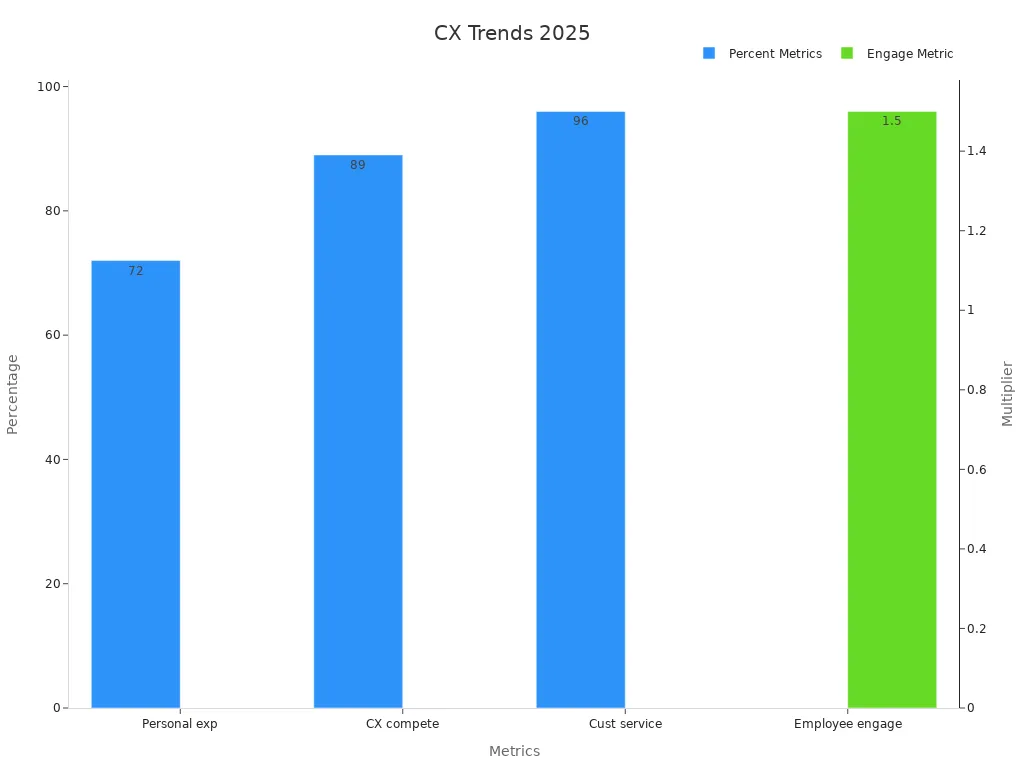
Integrating CSAT and NPS for a Holistic View
Combining CSAT and NPS gives you a complete picture of customer satisfaction. CSAT provides insights into specific interactions, while NPS assesses overall loyalty. Together, these metrics help you enhance customer journeys and satisfaction. For example, CSAT surveys reveal immediate issues, while NPS identifies promoters who can advocate for your brand.
Sobot’s solutions integrate both metrics into a unified workspace, allowing you to track customer feedback across channels. This holistic approach ensures you address short-term concerns while fostering long-term loyalty. By leveraging both metrics, you can optimize customer experiences and drive business growth.
- CSAT offers a deeper understanding of customer experiences beyond basic metrics.
- NPS assesses customer loyalty, yielding valuable insights into overall satisfaction.
- Utilizing both metrics helps teams enhance customer journeys and satisfaction.
Best Practices for Combining CSAT and NPS with Sobot Solutions
Leveraging Sobot’s Voice/Call Center for Real-Time Feedback

Real-time feedback is essential for improving customer satisfaction. Sobot’s Voice/Call Center enables you to collect immediate insights after customer interactions. Features like intelligent IVR and AI-powered Voicebot streamline the feedback process. For example, after a support call, the system can automatically prompt customers to rate their experience. This approach ensures you capture authentic responses while the interaction is still fresh in their minds.
Sobot’s platform also excels in performance metrics. Over two years, it reduced inbound discussion volume by 20% and increased positive feedback to 96%. The system achieved a 97% CSAT score and resolved 85% of issues efficiently. These results demonstrate how real-time feedback tools can enhance customer feedback programs and improve service quality.
| Metric | Value |
|---|---|
| Reduction in inbound discussion | 20% |
| Positive feedback percentage | 96% |
| CSAT score | 97% |
| Problem resolution rate | 85% |
Using Sobot’s Omnichannel Solution to Unify Metrics
Unifying metrics across channels is critical for a holistic view of customer satisfaction. Sobot’s Omnichannel Solution integrates CSAT and NPS surveys into a single platform. This unified workspace allows you to track customer feedback from voice, email, social media, and chat channels. By consolidating data, you can identify trends and address issues more effectively.
For instance, Samsung used Sobot’s omnichannel tools to achieve a 97% customer satisfaction rate. The solution streamlined communication and provided agents with comprehensive customer histories. This approach reduced repetitive interactions and improved service quality. The chart below highlights the performance metrics achieved with Sobot’s solutions:
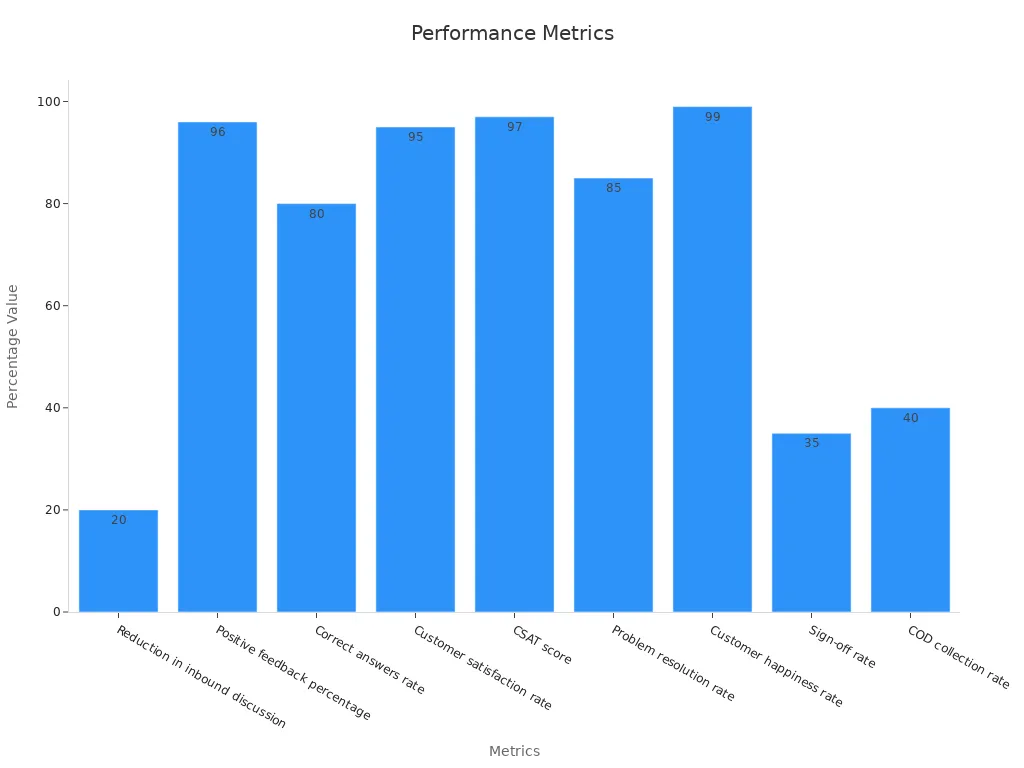
Actionable Strategies for Data Segmentation and Analysis
Effective data segmentation and analysis can transform how you measure customer satisfaction. Sobot’s solutions support advanced techniques like clustering algorithms to group customers dynamically. For example, you can segment customers based on behavior, purchase history, or feedback trends. This approach helps you tailor strategies to meet specific needs.
Leveraging big data is another powerful strategy. Sobot’s tools analyze vast amounts of digital interactions to uncover actionable insights. Real-time feedback integration further enhances this process. By understanding customer sentiments, you can make immediate improvements and refine your customer feedback programs.
Tip: Use Sobot’s analytics to monitor key metrics like CSAT and NPS. This data-driven approach ensures you stay ahead of evolving customer expectations.
CSAT and NPS serve distinct purposes in measuring customer satisfaction. CSAT captures immediate feedback after interactions, helping you identify areas for quick improvement. NPS evaluates long-term loyalty, revealing how customers perceive your brand overall. Together, these metrics provide a comprehensive view of satisfaction and loyalty.
For example:
- CSAT surveys after customer interactions highlight service quality and guide timely adjustments.
- Post-transaction CSAT surveys pinpoint areas needing improvement, ensuring swift responses.
- Enhanced onboarding processes boost retention and NPS scores, as engaged users become loyal advocates.
Adapting to trends in 2025 requires leveraging tools like Sobot’s solutions. These tools unify metrics, automate feedback collection, and provide actionable insights. By using both CSAT and NPS strategically, you can meet evolving expectations and stay competitive in delivering exceptional customer satisfaction.
FAQ
What is the main difference between CSAT and NPS?
CSAT measures how satisfied customers feel after specific interactions, while NPS evaluates their overall loyalty to your brand. CSAT focuses on short-term satisfaction, and NPS focuses on long-term relationships.
How can you improve customer satisfaction using CSAT?
You can improve customer satisfaction by analyzing CSAT survey results to identify weak points in your service. Addressing these issues promptly enhances the customer experience and builds trust.
Why is NPS important for your business?
NPS helps you understand customer loyalty and identify promoters who can advocate for your brand. This insight allows you to focus on building long-term relationships and increasing referrals.
Can you use CSAT and NPS together?
Yes, combining CSAT and NPS provides a complete view of customer satisfaction. CSAT highlights immediate concerns, and NPS reveals loyalty trends. Together, they help you improve experiences and foster loyalty.
How does Sobot simplify tracking CSAT and NPS?
Sobot’s tools automate feedback collection and unify metrics across channels. This approach ensures you gain actionable insights to improve customer satisfaction and loyalty effectively.
See Also
Comparative Analysis of Leading Voice of Customer Tools
Discovering the Best Cloud Contact Centers for 2025
Best 10 Voice of Customer Solutions to Use in 2024
